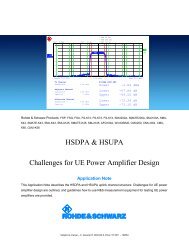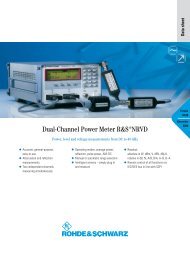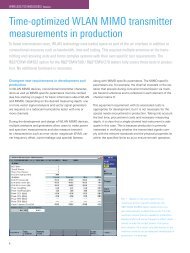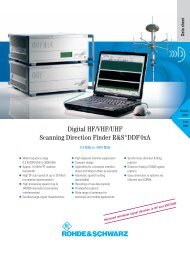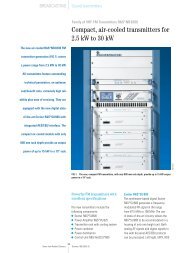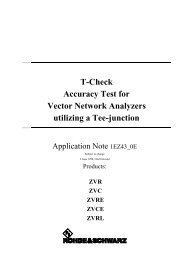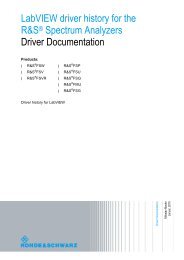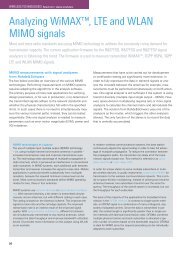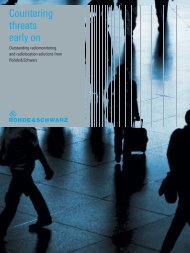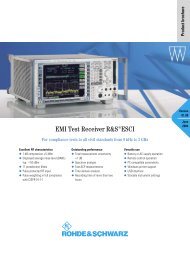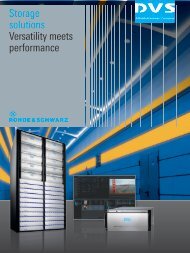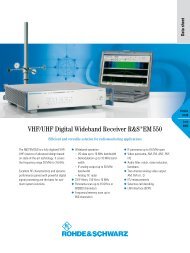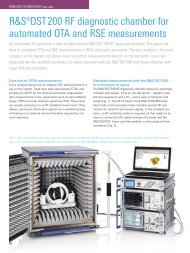English - Rohde & Schwarz
English - Rohde & Schwarz
English - Rohde & Schwarz
Create successful ePaper yourself
Turn your PDF publications into a flip-book with our unique Google optimized e-Paper software.
The SFQ output frequency range from<br />
0.3 MHz to 3.3 GHz enables tests far<br />
beyond the frequency range defi ned by<br />
the standard as well as measurements<br />
at any intermediate frequencies. The<br />
wide output level range of +3.2 dBm<br />
to –99.9 dBm allows measurements<br />
on high-sensitivity receiver modules<br />
but also transmission measurements at<br />
high levels.<br />
New, yet tried and tested<br />
Like the other successful SFQ models,<br />
the new model offers many proven features:<br />
user-friendly operation, messages<br />
indicating non-standard settings or<br />
operating states, status menus, online<br />
help, IEC/IEEE bus and RS-232-C interfaces<br />
as well as fi rmware updates from<br />
a PC. The future-oriented platform concept<br />
of the TV test transmitter has been<br />
designed to integrate coming modulation<br />
systems, so that SFQ is a profi table<br />
long-term investment.<br />
Günter Huber;<br />
Stefan Ritthaler<br />
The input signal at the coder (FIG 3)<br />
is an MPEG2-coded transport<br />
stream with a data rate of<br />
19.392658 Mbit/s and a packet<br />
length of 188 bytes.<br />
The sync detector at the coder input<br />
checks the input data stream for transport<br />
stream synchronization and, if<br />
the latter is in line with the standard,<br />
enables the output signal. The data<br />
are segmented to form the VSB data<br />
frame format, the frame structure<br />
being determined by segment and<br />
fi eld synchronization. Each segment<br />
comprises 208 bytes, ie the sync<br />
byte, three header bytes, 184 payload<br />
bytes and 20 FEC bytes.<br />
The randomizer links the data to<br />
a PRBS sequence to ensure constant<br />
power density in the channel.<br />
The data are block-coded in the<br />
Reed-Solomon encoder (207, 187,<br />
t = 10) for outer error correction.<br />
The 20 Reed-Solomon bytes of the<br />
FEC are calculated and added to<br />
each transport stream packet. The<br />
Operating principle of ATSC coder<br />
FEC bytes allow up to ten data bytes<br />
per transport stream packet to be<br />
corrected in the receiver.<br />
Burst-type interference on the transmission<br />
path causes series of errored<br />
symbols. An interleaver at the coder<br />
end and a corresponding deinterleaver<br />
at the receiver end distribute<br />
the errors to many Reed-Solomon<br />
blocks, ensuring that the number of<br />
errors per block is kept small enough<br />
for the Reed-Solomon decoder to<br />
correct them.<br />
Conversion of the data byte to the<br />
symbol to be transmitted takes place<br />
in the trellis encoder. Each byte is<br />
divided into four symbols, and the<br />
trellis encoder adds a parity bit for<br />
inner error correction to each dibit<br />
thus generated. This yields groups of<br />
tribits, each representing a symbol,<br />
which the mapper allocates to one of<br />
the eight amplitude levels. Vestigial<br />
sideband modulation is implemented<br />
by digital Hilbert transformation followed<br />
by analog I/Q modulation.<br />
Condensed data of SFQ<br />
Frequency range 0.3 MHz to 3.3 GHz<br />
Level range +3.2 dBm to –99.9 dBm<br />
Input data rate 19.392658 Mbit/s ±10 %,<br />
in packets of 188 bytes<br />
Output symbol rate 10.762 Msymbol/s ±10 %<br />
Signal bandwidth 6 MHz ±10 %<br />
Data inputs TS parallel (LVDS), ASI, SMPTE 310<br />
Modulation method 8T VSB<br />
Error simulation carrier suppression,<br />
I/Q imbalance,<br />
I/Q phase<br />
Special functions (switch-selected) scrambler, interleaver, Reed-Solomon, pilot,<br />
pilot amplitude variable<br />
Test signals null TS packets,<br />
null PRBS packets (2 15 –1 or 2 23 –1),<br />
sync PRBS (2 15 –1 or 2 23 –1),<br />
PRBS before/after trellis coding<br />
(2 15 –1 or 2 23 –1)<br />
Reader service card 166/04<br />
Articles<br />
News from <strong>Rohde</strong> & <strong>Schwarz</strong> Number 166 (2000/I) 15



